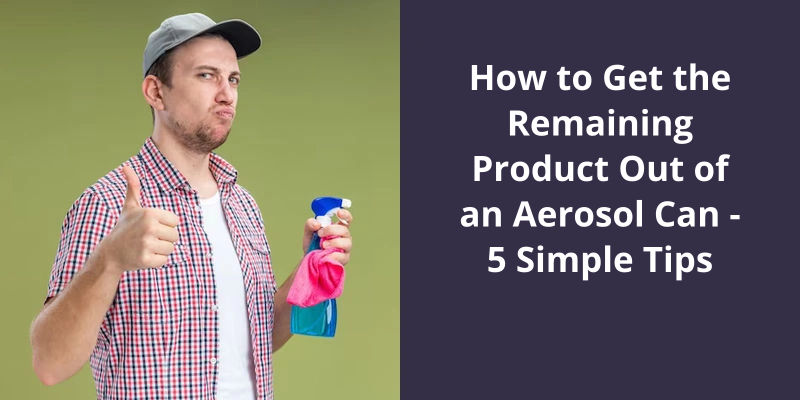Getting the remaining product out of an aerosol can is a simple process when followed carefully. Begin by ensuring your safety – handle the can carefully to avoid any accidental discharge. Next, bring the can to room temperature by leaving it in a safe, temperate space for a while as bringing it to room temperature can increase the pressure inside the can, pushing out more product. Shaking the can thoroughly could also help, as the action helps to mix the product with the propellant to enable you to get out more of it. If the can still refuses to give out the product, try using it in a different position. Sometimes, turning the can upside down or to the side can help to access leftover product. Finally, if you find that there is still product that can’t be accessed, you might consider cutting open the can. However, this should be the last resort and should be done extremely carefully, bearing in mind that it can be dangerous, especially if there’s pressurized propellant left in the can.

What Happens if You Pierce an Aerosol Can?
Aerosol cans are commonly used products in our daily lives. They come in various sizes and are often filled with substances like sprays, paints, and other chemicals. With the overwhelming number of aerosols in our homes and workplaces, it’s important to know how to handle them safely. One of the most crucial pieces of advice to follow is to never pierce an aerosol can.
Why is piercing an aerosol can so dangerous? It’s because these canisters are pressurized. When the seal is broken, the internal pressure is released, causing the contents to shoot out uncontrollably. The pressure inside an aerosol can can be as high as 90 psi, which can cause major explosions when the can is pierced. This is especially true if the contents are flammable or under high pressure.
It’s important to note that even when an aerosol can appears to be empty, it may still have some pressure inside. This leftover pressure can cause the can to burst unexpectedly, leading to injury and damage. Instead of puncturing the can to get every last drop, it’s better to dispose of it properly. Most aerosol cans are recyclable, and local waste management facilities will have instructions on how to properly dispose of them.
Storing aerosols correctly is also essential to ensuring their safe use. These cans should be kept in a cool, dry place, away from any sources of heat or direct sunlight. This will help prevent the pressure inside the can from increasing and potentially causing it to burst. It’s also important to keep aerosols away from any potential ignition sources, such as electrical equipment or open flames.
They should be stored in a cool, dry place away from heat and potential ignition sources. These precautions will help ensure your safety and the safety of those around you when dealing with these pressurized products.
Now that we know aerosol cans are made of thin sheets of steel and contain highly pressurized products, it’s important to understand the potential dangers associated with them. Improper usage and disposal of aerosol cans can harm both human health and the environment. Let’s take a closer look at these risks and how to properly handle spray cans.
Are Spray Cans Pressurized?
This pressure allows the products inside to be released from the can in a fine spray or mist. The pressure in a typical aerosol can is generally around 80-100 psi (pounds per square inch) at room temperature. This is enough to expel the contents of the can with force, but not so much as to make it dangerous or difficult to handle.
This gas is both liquified and compressed, which allows it to exert a high amount of pressure on the product inside. The most commonly used propellants in aerosol cans are butane, propane, and isobutane. These gases are inert and don’t react with the product inside, making them ideal for use in aerosol cans.
The process of filling aerosol cans can be quite complex and requires specialized equipment. The product that will be sprayed from the can is placed in the can, which is then sealed. The propellant gas is then added, filling the remaining space in the can. The pressure inside the can is closely monitored to ensure that it’s within safe levels.
Despite their usefulness, aerosol cans can pose a hazard if not used and disposed of properly. The high pressure inside the can can make it dangerous if punctured or heated, and some of the propellants used in aerosol cans are flammable. It’s important to follow the instructions on the can carefully, and never puncture or incinerate an aerosol can.
History of Spray Cans and Their Development Over Time
Spray cans have a fascinating history and have come a long way since their invention. The first spray can was developed in 1949, and by the 1960s, they were being used extensively for household and commercial purposes. Over time, spray cans have been improved and adapted for various applications, including automotive, construction, and artistic uses. Today, they’re an essential tool for many industries and hobbies.
It’s no secret that aerosol cans are often discarded after just a single use. However, this wastefulness is slowly being addressed by regulations such as the aerosols universal waste rule, allowing handlers to prolong the life of these seemingly disposable products. One method to achieve this is by puncturing and draining aerosol cans, which not only makes them easier to recycle, but also helps reduce waste in landfills. In this article, we’ll explore the process of draining an aerosol can and delve into the benefits of doing so.
Can You Drain an Aerosol Can?
Aerosol cans have been in use for well over half a century. They’re a common household commodity found in every home and are used to spray different types of products such as deodorants, insect repellents, and cooking sprays. However, when these cans are emptied, they become hazardous waste that needs proper disposal. One of the ways to dispose of aerosol cans is by draining them.
This process is essential in reducing the amount of waste sent to landfills and also saves energy by recycling scrap metals. The aerosol universal waste rule was created by the Environmental Protection Agency (EPA) to regulate the treatment and disposal of aerosol cans. This rule mandates that aerosol cans are hazardous and must be disposed of properly.
To drain an aerosol can, a qualified handler must first determine if it’s empty or has leftover content. A good way to test this is by shaking the can and listening for the sound of liquid or gas. Once it’s been determined that there’s no product left in the can, the handler will puncture it. Puncturing the can won’t only allow the leftover product to be drained, but it also ensures that the can doesn’t re-pressurize, making it safe for disposal.
Proper puncturing and draining of aerosol cans will make them suitable for recycling as scrap metal. This process not only saves energy but also has a positive impact on the environment. Scrap metal recycling reduces the need for mining raw materials, which can lead to air and water pollution. Recycling also saves energy and reduces greenhouse gas emissions.
The Dangers of Improperly Disposing of Aerosol Cans
Improper disposal of aerosol cans can be hazardous to humans and the environment. These cans contain pressurized chemicals that can explode if punctured or crushed. The chemicals can also cause harm to the environment and wildlife if they aren’t disposed of properly. It’s important to follow local regulations and recycle or dispose of aerosol cans at designated facilities.
Understanding the pressure of gas in an aerosol can is essential in many different applications, from industrial processes to household cleaning products. The gas pressure in an aerosol can is typically measured in atmospheres (atm) and can vary depending on factors such as the contents of the can and the surrounding temperature. In this article, we will explore the significance of gas pressure in aerosol cans and the various factors that can affect it.
What Is the Pressure of Gas in the Aerosol?
When we talk about aerosols, were essentially referring to substances that exist in a gaseous state that have been pressurized and stored in a container. With the help of propellants, aerosols can be dispensed from these containers in a controlled manner. The pressure inside an aerosol can plays a crucial role in determining the efficacy of the dispenser mechanism. In laymans terms, the pressure of the gas in an aerosol determines how forcefully the contents of the container will be dispensed when the valve is triggered.
The pressure inside an aerosol can is influenced by various factors such as temperature, volume, and the type of gas used as the propellant. Typically, the pressure inside an aerosol can is measured in atmospheres (atm), which is a unit of measurement that’s used to describe the amount of pressure exerted by a gas. For example, the gas pressure in an aerosol can is 1.8 atm at 25 degrees Celsius.
As the temperature of the gas inside the can increases, the pressure increases as well. Likewise, as the temperature decreases, the pressure also decreases. This is why it’s important to store aerosol cans in cool and dry places to avoid excess pressure buildup.
It’s also worth noting that the type of gas used in an aerosol can play a huge role in determining the pressure inside the can. Some common propellants include butane, propane, and isobutene. These gases have different molecular weights, which means they’ll exert different pressures at the same temperature. Other gases such as nitrogen, carbon dioxide, and compressed air can also be used as propellants.
Now that you know how to revive a clogged spray can, let’s delve deeper into the various techniques to make your next DIY project a success. From preparing the surface to mastering the spraying technique, we’ll cover everything you need to know to achieve professional-looking results every time.
How Do You Make a New Spray Can Work?
If your spray can isn’t new but has been used before, it may need to be shaken before use to ensure that the ingredients are mixed properly. This is especially important if the can has been sitting for a while or if it’s been stored in extreme temperatures. Shaking the can helps to mix the ingredients and ensures that the spray comes out evenly.
Before using a new spray can, it’s important to read the instructions on the can carefully. This will give you an idea of how much pressure is required to make the can work and how far away from the surface you should hold the can.
When using a new spray can for the first time, it’s important to test the spray on a small surface to see how it looks and how far it sprays. This will give you an idea of what to expect when you use the spray on larger surfaces. It’s also important to wear protective clothing and use the spray in a well-ventilated area to avoid inhaling any potentially harmful fumes.
Making a new spray can work is easy if you follow a few simple steps. Hold the can upside down, shake it well before use, and follow the instructions on the can carefully. It’s also important to test the spray on a small surface before using it on larger surfaces and to wear protective clothing and use the spray in a well-ventilated area. With these tips in mind, you can make your new spray can work like a pro.
Source: When you buy a spray can, and it doesn’t work, is there …
Conclusion
In today's world, sustainability and reducing waste have become important topics. There are several methods to do so, such as using warm water or a straw. However, it’s crucial to keep in mind the safety precautions while handling aerosol cans. It’s also worth noting that reducing the use of aerosol cans altogether by opting for more sustainable alternatives is an important step towards a better future. In conclusion, taking simple steps to get the remaining product out of an aerosol can can contribute to reducing waste and promoting sustainability.





